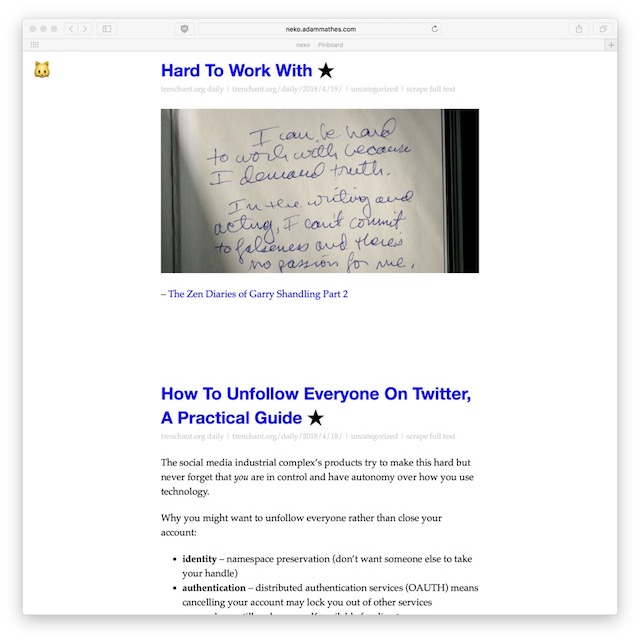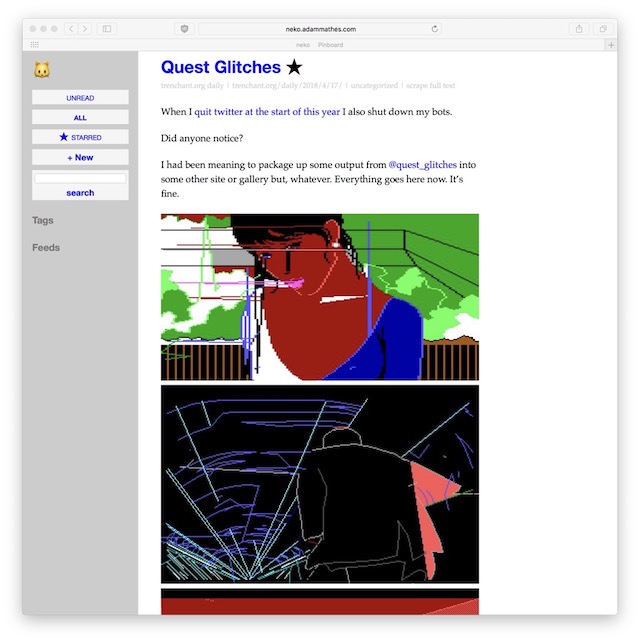██
██
██
██░████ ░████▒ ██ ▓██▒ ░████░
███████▓ ░██████▒ ██ ▓██▒ ░██████░
███ ▒██ ██▒ ▒██ ██▒██▒ ███ ███
██ ██ ████████ ████▓ ██░ ░██
██ ██ ████████ █████ ██ ██
██ ██ ██ ██░███ ██░ ░██
██ ██ ███░ ▒█ ██ ██▒ ███ ███
██ ██ ░███████ ██ ▒██ ░██████░
██ ██ ░█████▒ ██ ███ ░████░
v0.2 manual
7/4/2018
Table of Contents
Neko
neko is a self-hosted, rss reader focused on simplicity and efficiency.
Backend is written in Go and there is a simple javascript frontend and cat ears.
note: the cat ears are in your mind
Features
- limited features (#1 feature)
- keyboard shortcuts
- j - next item
- k - previous item
- that's all you should ever need
- automatically marks items read in an infinite stream of never-ending content (until you run out of content and it ends)
- full text search
- scrapes full text of pages on demand
Screenshots


Installation
Requirements
If you are using a binary, no dependencies!
NOTE: I haven't put up any binaries yet.
Building
Dependencies
- Go
-
$ go get adammathes.com/neko
This will download neko, dependencies, and build them all in $GOPATH/src/. By default this should be something like $HOME/go/src/.
A neko binary should now be in $GOPATH/bin/. By default this is usually $HOME/go/bin/
Configuration
There's no configuration file -- everything is handled with a few command line flags. You shouldn't need to change the defaults most of the time.
Storage
By default neko will create the file neko.db in the current directory for storage.
You can override the location of this database file with the --database command line option.
$ neko --database=/var/db/neko.db --add=http://trenchant.org/rss.xml
For expert users -- this is a SQLite database and can be manipulated with standard sqlite commands --
$ sqlite3 neko.db .schema
-- will print out the database schema.
Usage
Web Interface
You can do most of what you need to do with neko from the web interface, which is what neko does by default.
$ neko
neko web interface should now be available at 127.0.0.1:4994 -- opening a browser up to that should show you the interface.
You can specify a different port using the --http option.
$ neko --http=9001
If you are hosting on a publicly available server instead of a personal computer, you can protect the interface with a password flag --
$ neko --password=rssisveryimportant
Add Feed
You can add feeds directly from the command line for convenience --
$ neko --add=http://trenchant.org/rss.xml
Crawl Feeds
Update feeds from the command line with --
$ neko --update
This will fetch, download, parse, and store in the database your feeds.
Export
Export de facto RSS feed standard OPML from the command line with --
$ neko --export=opml
Change opml to text for a simple list of feed URLs, or json for JSON formatted output.
Export is also available in the web interface.
Import of OPML and other things is a TODO item.
All Command Line Options
View all command line options with -h or --help
$ neko -h
Usage of neko: -a, --add http://example.com/rss.xml
add the feed at URL http://example.com/rss.xml
-d, --database string
sqlite database file (default "neko.db")
-x, --export string
export feed. format required: text, json or opml
-h, --help
print usage information
-s, --http int
HTTP port to serve on (default 4994)
-i, --imageproxy
rewrite and proxy all image requests for privacy (experimental)
-p, --password string
password to access web interface
-u, --update
fetch feeds and store new items
-v, --verbose
verbose output
TODO
- manually initiate crawl/refresh from web interface
- auto-refresh feeds from web interface
- import
- mark all as read
- rewrite frontend in a modern js framework
- prettify interface
- cross-compilation of binaries for "normal" platforms
History
Early 2017
I decided I didn't like the original version of this that was python and mongo so rewrote it. I wanted to learn some Go. So assume the code is not great since I don't know what I'm doing even more so than normal.
The Javascript frontend is still the same, I keep saying I will rewrite that too since it's old backbone.js code but it still seems to mostly work. It's not very pretty though.
July 2018 -- v0.2
Significant changes to simplify setup, configuration, usage. The goal was typing neko should be all you need to do to get started and use the software.
- removed MySQL requirement (eliminating a ton of configuration and complexity)
- added SQLite support (easier!)
- auto-initialization of database file with embedded schema
- removed json-formatted config file -- all options are command line options
nekoruns web server by defaultnekoserver crawls feeds regularly rather than requiring cron
Feedback
Pull requests and issues are welcomed at https://github.com/adammathes/neko